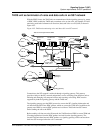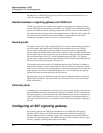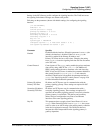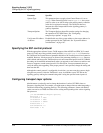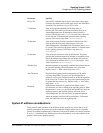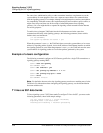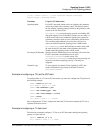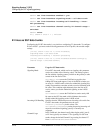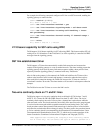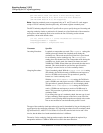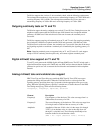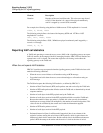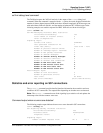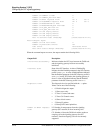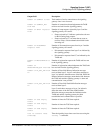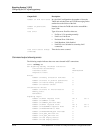
Signaling System 7 (SS7)
Configuring an SS7 signaling gateway
APX 8000/MAX TNT/DSLTNT Physical Interface Configuration Guide Preliminary May 9, 2000 18-11
For example, the following commands configure an E1 line as an SS7 data trunk, enabling the
signaling gateway to control the line:
admin> read e1 {1 10 1}
E1/{ shelf-1 slot-10 1 } read
admin> set line-interface enabled = yes
admin> set line-interface signaling-mode = ss7-data-trunk
admin> set line-interface incoming-call-handling = inter-
nal-processing
admin> set line-interface channel-config 17 channel-usage =
switched
admin> write
E1/{ shelf-1 slot-10 1 } written
V.110 bearer capability for SS7 calls using IPDC
TAOS supports V.110 bearer capability for SS7 calls using IPDC. This feature enables SS7 call
routing across V.110 interfaces in the TAOS unit. Use of this capability is controlled via IPDC
messages from the signaling gateway.
SS7 link establishment timer
TAOS supports a T5 timer that automatically enables link connection and reconnection
requests to the signaling gateway to occur at random intervals. The timer can help prevent the
signaling gateway from receiving many link connect requests within a short period of time,
especially when the signaling gateway is connected with many TAOS units.
After its link to the gateway is disconnected, the TAOS unit initializes the T5 timer with a
random value between 0 and 6 seconds and attempts a connection when the timer expires.
After each failed connection attempt, the TAOS unit increases the T5 time-out value by 1
second until it reaches 20 seconds. The timer remains at 20 seconds for subsequent connection
attempts.
The TAOS unit resets the T5 timer as soon as the link is active.
Two-wire continuity check on T1 and E1 lines
TAOS units support a 4-wire-only continuity check as defined in Q.724 Sections 7 and 8,
ANSI T1.113.4 Annex B, GR-246-CORE Annex B on both T1 and E1 lines. The 4-wire
continuity check requires one end of a line to place a channel into loopback state while the
other end sends a tone. The check concludes successfully if the tone sent on the outgoing path
is received on the return path within acceptable transmission and timing limits. The 4-wire
check procedure cannot detect potential inadvertent loops in the line path or in line facilities,
and cannot be used when the other exchange is analog. For these reasons, the procedure known
as 2-wire continuity check is recommended by the International Telecommunications Union
Telecommunication Standardization Sector (ITU-T), which carries out the operations of the
former Consultative Committee for International Telephone and Telegraph (CCITT).
TAOS supports both incoming and outgoing 2-wire continuity checks
for T1 lines only. You can select the type of check to perform on a



